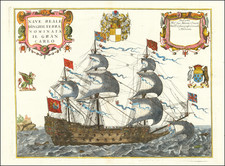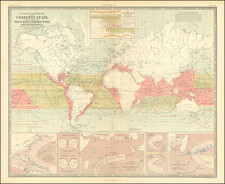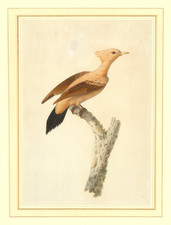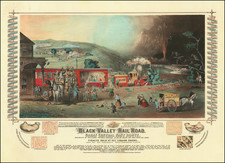Interesting portrait of the Dutch circumnavigator Olivier Van Noort, which appeared in De Bry's account of his travels.
Includes a double hemisphere map of the world and images of 2 Native Americans.
Olivier Van Noort
Olivier van Noort (1558-1627) was a Dutch merchant captain and pirate and the first Dutch person to circumnavigate the world.
Van Noort left Rotterdam on July 2, 1598 with four ships and a plan to attack Spanish possessions in the Pacific and to trade with China and the Spice Islands during the Eighty Years' War between the Netherlands and Spain. His ships were poorly equipped, especially in the way of armament and the crews were unruly.
Van Noort sailed through the Magellan Strait, and captured a number of ships (Spanish and otherwise) along the Pacific coast of South America. He lost two ships on the way due to a storm, including his largest ship, the Hendrick Frederick, which was wrecked on Ternate in the Maluku Islands.
In November and December 1600, he established a berth for his two remaining sailboats, Mauritius and Eendracht, in Manila Bay in the Philippines. From there he engaged raided along the sailing route to and from Manila. This situation was ended after the naval combat of Fortune Island on December 14, 1600. The Spanish lost their flagship, the galleon San Diego, but the Spanish captured the Eendracht, making van Noort's position untenable and forcing him to retire from the Philippines.
Van Noort returned to Rotterdam via what would become the Dutch East Indies and the Cape of Good Hope on August 26,1601 with his last ship, the Mauritius, and 45 of originally 248 men. The venture barely broke even, but was the inspiration for more such expeditions. The united Dutch East India Company was formed a few months later.
Theodor de Bry (1528-1598) was a prominent Flemish engraver and publisher best known for his engravings of the New World. Born in Liege, de Bry hailed from the portion of Flanders then controlled by Spain. The de Brys were a family of jewelers and engravers, and young Theodor was trained in those artisanal trades.
As a Lutheran, however, his life and livelihood were threatened when the Spanish Inquisition cracked down on non-Catholics. De Bry was banished and his goods seized in 1570. He fled to Strasbourg, where he studied under the Huguenot engraver Etienne Delaune. He also traveled to Antwerp, London, and Frankfurt, where he settled with his family.
In 1590, de Bry began to publish his Les Grands Voyages, which would eventually stretch to thirty volumes released by de Bry and his two sons. The volumes contained not only important engraved images of the New World, the first many had seen of the geographic novelties, but also several important maps. He also published a collection focused on India Orientalis. Les Grands Voyages was published in German, Latin, French, and English, extending de Bry’s fame and his view of the New World.









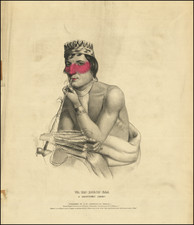
![Historiarum Indicarum Libri XVI [with:] Indiarum Orientalium Occidentaliumque Descriptio. Pet. Maffei Historiae Harum Verissimae, Dedicata.](https://storage.googleapis.com/raremaps/img/small/102793.jpg)
